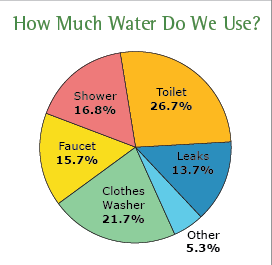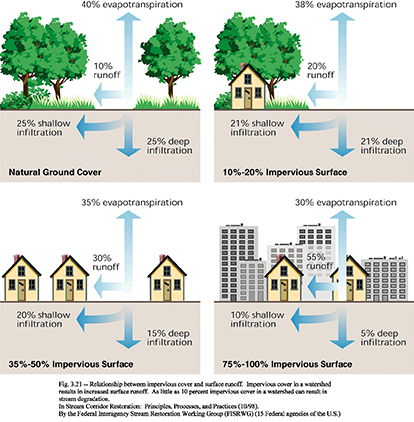Stormwater General Public
Safe, clean water is such an integral part of our lives that it can easily be taken for granted. The average American family uses more than 300 gallons of water per day at home. Roughly 70% of this use occurs indoors with 30% being used outdoors.

In Morgantown alone, our water treatment plant treats an average of 10.5 million gallons of water a day. Roughly 80% of this water comes from the Monongahela River while the remaining amounts come from the Cobun Creek Reservoir.
The sources of our drinking water are important to keep in mind because what goes into these water resources can adversely impact the quality- and even the safety- of our drinking water. And despite common public perception, most daily pollutants of our water resources doesn’t come from large businesses but rather from households such as yours!
This is why it’s important to understand what you can do to limit and eliminate household contaminants from entering our water supply. Below is a list of items that comprise the most significant threats to our water resources. Please click on a link to understand the threat and keep your family safe.
If you have questions feel free to email us at stormwater@mub.org or call 304-296-8443. To see some of the things we’ve been doing, and what we have planned, to protect our water resources, check out our Stormwater Events page here.
Remember: Safe water is everyone’s responsibility. If you see something askew, call 296-4322 (area code 304).
Understanding Stormwater – What Happens When It Rains
When it rains, water runs off impervious surfaces (i.e., driveways, roads, roofs) and along the ground, across gravel lots, etc. As it does it collects various materials and liquids and carries these down the stormwater culvert. Naturally, the amount of water that flows off these surfaces depends on the pervious nature of the surface itself. The image below provides an example of how this works (click the image for a larger display in a pop-up window).

Once in the culvert, these contaminants are washed into local rivers and streams. In Morgantown, this includes sources that directly impact our drinking water: the Monongahela River, Deckers Creek and Cobun Creek. Examples of contaminants include—
- Litter
- Automotive liquids such as oils and antifreezes
- Soaps and other items used outside (i.e., washing house siding, washing a car)
- Gravel
- Soils
- Grass clippings
- Pet waste
- And many other items
The same can be said for hazardous household wastes that are poured down the drain in our home or flushed down a toilet. During a period of excessive rainfall, these items can be directly released into Deckers Creek and the Monongahela River via Combined Sewer Overflows (CSOs). [To learn more about local CSOs, please click here.]
While all of this may not seem like a lot as it relates to a single household, the combined urban impact can be considerable. This is why your participation in protecting our water resources is so important. It all begins with you.
So please take a moment to review the information provided below. And again, if you have questions or concerns email us at stormwater@mub.org or call 304-296-8443.
Potential Household Threats to Our Water Resources
Below are the most common household threats to our water resources. Click on a link below to learn more about each contaminant and how you can help reduce and eliminate each from our water resources.
- Pet Waste
- Lawn Care
- Automotive Care
- Household Hazardous Waste
- Medications (This will take you to the FDA website)
What You Can Do To Help
While the above pages provide a wealth of excellent information on how to manage various threats, one of the best ways to protect our water resources is 'green infrastructure'. This entails using vegetation, soils, and natural processes that mimic nature by soaking up and storing water rain water. The EPA has a terrific site on a variety of green infrastructure elements that range from smaller scale elements that can be integrated into sites to the larger scale elements that span entire watersheds. To visit the EPA's site click here.
Be sure to take our stormwater survey by clicking here!